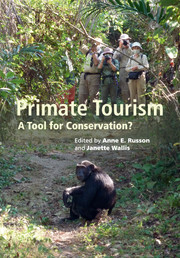Book contents
- Frontmatter
- Contents
- List of contributors
- Part I Introduction
- Part II Asian primates
- 2 Tourism, infant mortality, and stress indicators among Tibetan macaques at Huangshan, China
- 3 Provisioning and tourism in free-ranging Japanese macaques
- 4 Proboscis monkey tourism
- 5 Orangutan tourism and conservation
- 6 The impact of tourism on the behavior of rehabilitated orangutans (Pongo abelii) in Bukit Lawang, North Sumatra, Indonesia
- Part III African primates
- Part IV Neotropical primates
- Part V Broader issues
- Part VI Conclusion
- Index
- References
3 - Provisioning and tourism in free-ranging Japanese macaques
from Part II - Asian primates
Published online by Cambridge University Press: 05 September 2014
- Frontmatter
- Contents
- List of contributors
- Part I Introduction
- Part II Asian primates
- 2 Tourism, infant mortality, and stress indicators among Tibetan macaques at Huangshan, China
- 3 Provisioning and tourism in free-ranging Japanese macaques
- 4 Proboscis monkey tourism
- 5 Orangutan tourism and conservation
- 6 The impact of tourism on the behavior of rehabilitated orangutans (Pongo abelii) in Bukit Lawang, North Sumatra, Indonesia
- Part III African primates
- Part IV Neotropical primates
- Part V Broader issues
- Part VI Conclusion
- Index
- References
Summary
Introduction
Primate-focused tourism in Japan began with provisioning after World War II. Researchers from Kyoto University formed the Primate Research Group in 1951 and searched extensively for good sites to study Japanese macaques (Macaca fuscata) in their natural habitats (Yamagiwa, 2010). The macaques were frightened of humans, however, because of past hunting and chasing pressures from the farmland inhabitants. Therefore, researchers tried provisioning to habituate macaques to humans and this finally succeeded at Koshima and Takasakiyama in 1952 (Yamagiwa, 2010). Provisioning allowed researchers to conduct long-term observational studies with individual identification that produced many important findings on the elements of macaque social organization, such as dominance rank among individuals and kin groups, and cultural behaviors (reviewed by Yamagiwa, 2010).
These scientific findings, along with newspaper articles and TV programs on Japanese macaques and their behavior, made these macaques interesting to people other than researchers and led to the establishment of commercial free-ranging monkey parks. Such monkey parks, where visitors could observe provisioned free-ranging Japanese macaques up close, were established in Japan from the 1950s (Mito & Watanabe, 1999; Nakagawa et al., 2010; Yamagiwa, 2010). They became an important recreational activity for the Japanese people at a time when the country as a whole was recovering from World War II. Mito and Watanabe (1999) identified five factors that led to the popularity of such monkey parks in Japan at that time: (1) there was little opportunity for recreation after World War II; (2) such monkey parks needed little initial investment; (3) visitors could observe wild macaques without being separated from them by fences or cages; (4) park managers felt their jobs were worthwhile because people enjoyed visiting free-ranging monkey parks; and (5) the development of primatology in Japan increased Japanese people’s interest in the social structure and behavior of Japanese macaques. People who visited monkey parks were delighted to learn about new findings by primatologists. The provisioning that allowed visitors to observe these macaques easily, however, eventually caused drastic increases in macaque population sizes and this in turn led to agricultural and forest damage.
- Type
- Chapter
- Information
- Primate TourismA Tool for Conservation?, pp. 44 - 55Publisher: Cambridge University PressPrint publication year: 2014
References
- 7
- Cited by

